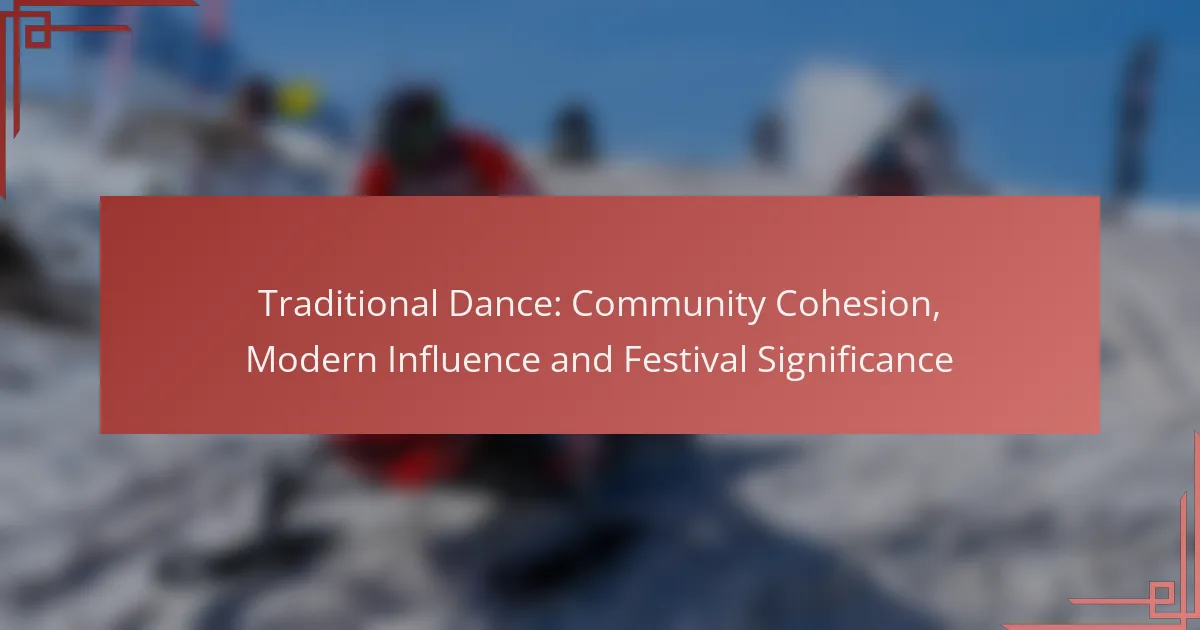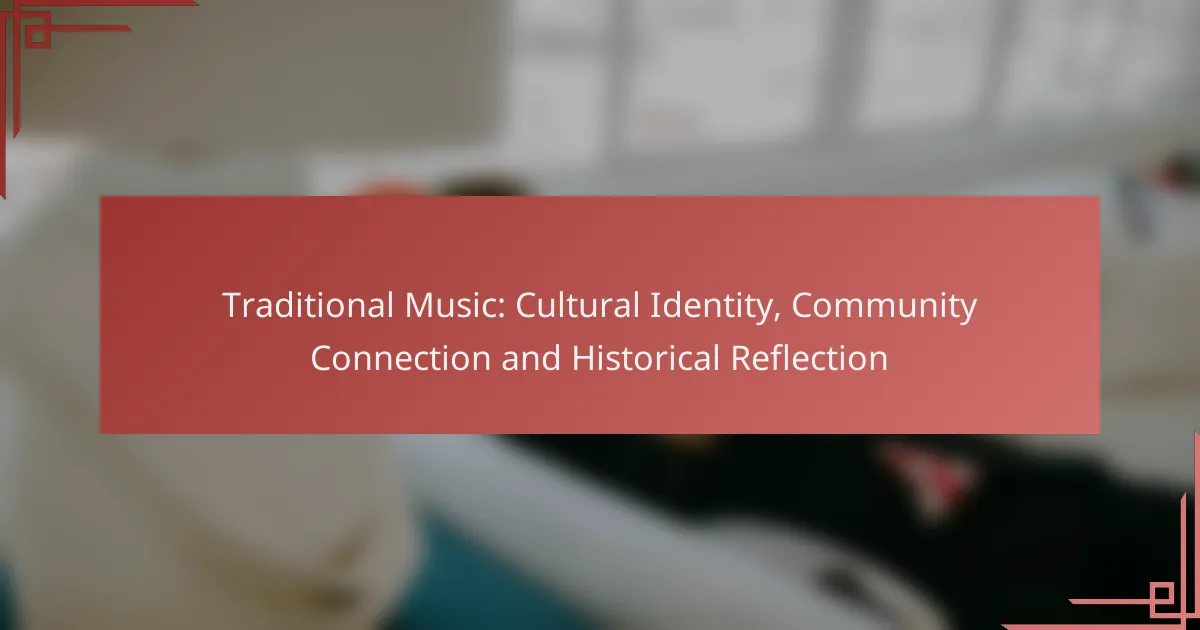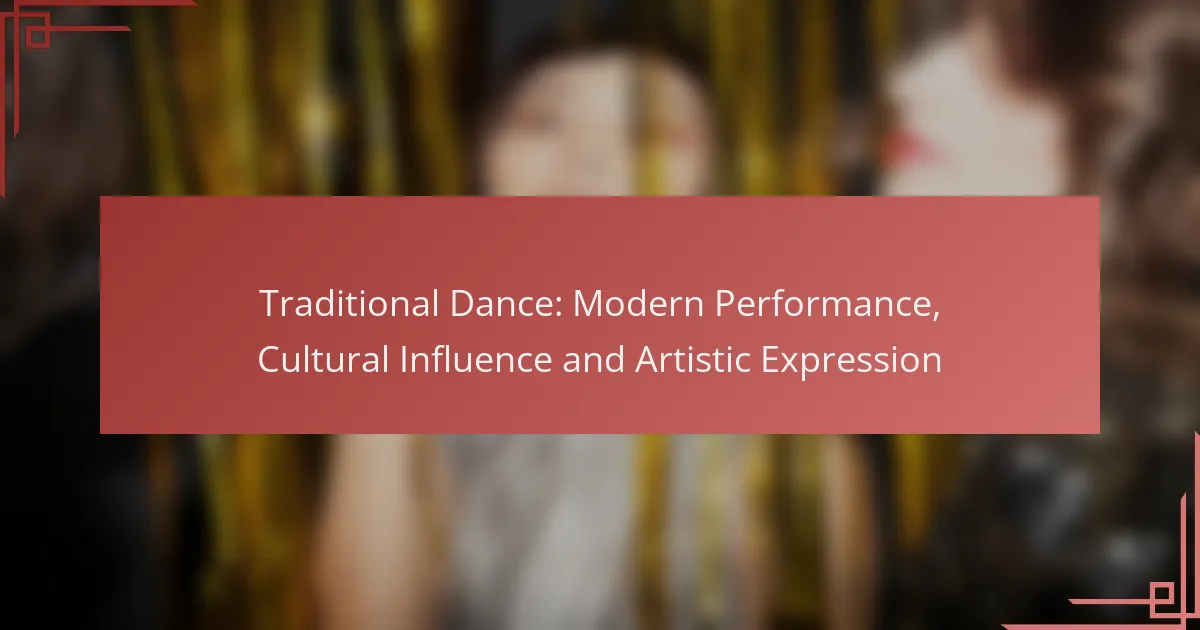Traditional dance serves as a vital means of fostering community cohesion, uniting individuals through shared cultural practices and collective participation. While modern influences introduce new styles and trends, they also challenge the authenticity of these age-old traditions. Festivals celebrating traditional dance play a significant role in enhancing cultural identity, strengthening community ties, and stimulating local economies.

How does traditional dance promote community cohesion in the UK?
Traditional dance fosters community cohesion in the UK by bringing people together through shared cultural practices and collective participation. It serves as a medium for social interaction, allowing individuals to connect and strengthen their bonds within the community.
Fosters social connections
Traditional dance creates opportunities for individuals to meet and engage with one another, often transcending age and background. Community dance events, such as ceilidhs or morris dancing gatherings, encourage participation from everyone, helping to build friendships and networks.
These social gatherings often involve group activities where participants learn dances together, creating a sense of belonging and teamwork. Regular involvement in such events can lead to lasting relationships and a supportive community environment.
Encourages cultural exchange
Traditional dance acts as a platform for cultural exchange, allowing diverse communities to share their unique heritage. Events that showcase various dance forms, such as folk festivals, invite participants from different backgrounds to learn and appreciate each other’s traditions.
This exchange not only enriches the participants’ understanding of different cultures but also promotes inclusivity and respect. By engaging with various dance styles, communities can celebrate their differences while finding common ground.
Strengthens local identity
Engaging in traditional dance helps reinforce local identity by celebrating regional customs and history. Each dance often tells a story or represents a specific aspect of local culture, allowing participants to connect with their roots.
As communities come together to practice and perform these dances, they cultivate a shared sense of pride and ownership over their cultural heritage. This connection to local traditions can enhance community spirit and resilience, making it a vital aspect of social cohesion in the UK.

What is the impact of modern influences on traditional dance?
Modern influences significantly shape traditional dance by introducing new styles, technologies, and global trends. These changes can enhance the appeal of traditional forms while sometimes challenging their authenticity and cultural significance.
Integration of contemporary styles
Contemporary styles often blend with traditional dance forms, creating innovative performances that attract diverse audiences. For example, hip-hop elements may be incorporated into folk dances, making them more relatable to younger generations.
This integration can lead to a richer artistic expression but may also dilute the original cultural meanings. Dancers and choreographers should balance innovation with respect for traditional roots to maintain cultural integrity.
Use of technology in performances
Technology plays a crucial role in modern dance performances, enhancing visual effects and audience engagement. Lighting, sound design, and digital projections can transform a traditional dance into a multi-sensory experience.
However, reliance on technology can overshadow the dance itself. Performers should ensure that technological elements complement rather than dominate the traditional aspects of their art.
Influence of global dance trends
Global dance trends, fueled by social media and international collaborations, impact traditional dance by introducing new movements and styles. Dancers may adopt popular global trends, which can lead to a fusion of cultural expressions.
While this can broaden the appeal of traditional dance, it is essential to remain aware of cultural appropriation. Dancers should strive to honor the origins of the styles they incorporate, ensuring that their performances reflect a genuine appreciation of the cultures involved.
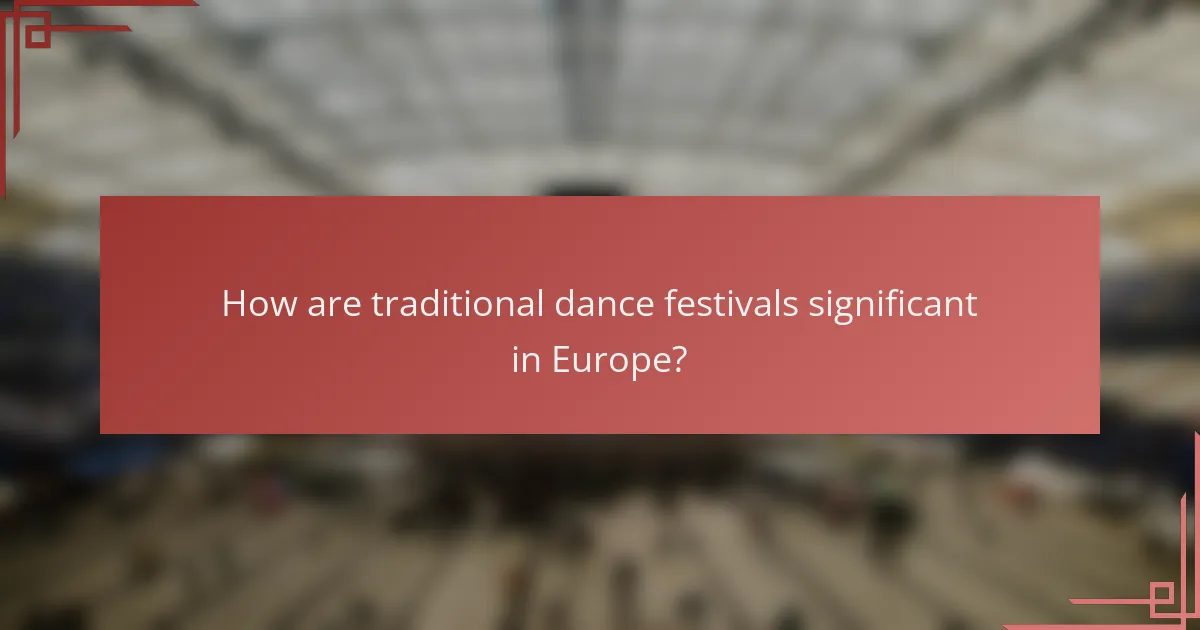
How are traditional dance festivals significant in Europe?
Traditional dance festivals in Europe play a crucial role in celebrating cultural identity, fostering community ties, and boosting local economies. These events not only showcase unique heritage but also attract visitors, enhancing social cohesion and economic vitality.
Showcase of cultural heritage
Traditional dance festivals serve as vibrant platforms for showcasing the rich cultural heritage of various European regions. They feature local dances, music, and costumes that reflect historical narratives and community values.
Participants often engage in performances that have been passed down through generations, preserving unique traditions. This not only educates attendees about the local culture but also strengthens community pride and identity.
Economic benefits for local communities
Local communities experience significant economic benefits from traditional dance festivals. These events can generate revenue through ticket sales, food and craft vendors, and accommodation bookings, often resulting in thousands of euros for small towns.
Moreover, festivals create temporary jobs and stimulate local businesses, providing a boost to the economy during the event period. Communities can expect increased foot traffic and spending, which can lead to long-term economic growth.
Promotion of tourism
Traditional dance festivals are effective in promoting tourism, drawing visitors from both nearby regions and abroad. By highlighting unique cultural experiences, these festivals attract tourists looking for authentic local interactions.
Marketing strategies often include partnerships with travel agencies and online platforms to reach a wider audience. Successful festivals can become annual attractions, contributing to sustained tourism growth and increased visibility for the host community.
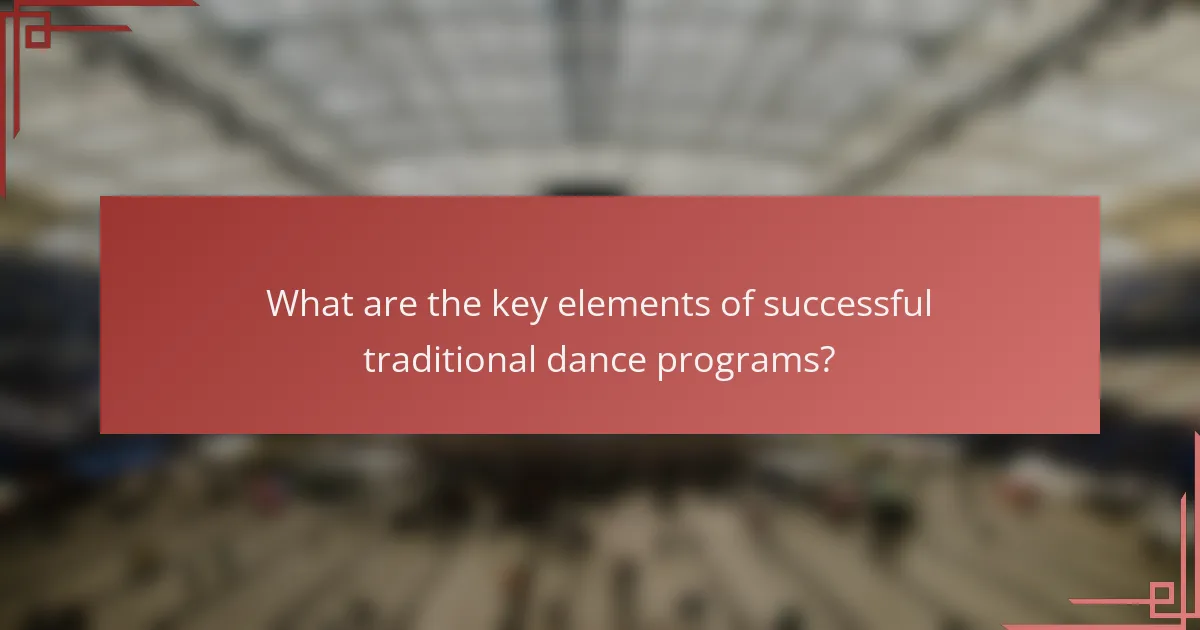
What are the key elements of successful traditional dance programs?
Successful traditional dance programs rely on community involvement, access to training and resources, and support from local organizations. These elements foster engagement, skill development, and sustainability within the dance community.
Community involvement
Community involvement is crucial for the success of traditional dance programs. Engaging local participants not only enhances the cultural relevance of the dance but also builds a sense of belonging and pride among community members.
To encourage participation, programs can host open workshops, invite local schools to join, and organize community performances. These initiatives help to create a vibrant dance culture that resonates with the community’s identity.
Access to training and resources
Access to training and resources is essential for nurturing talent in traditional dance. Programs should provide opportunities for dancers of all ages to learn from experienced instructors, whether through classes, online tutorials, or mentorship arrangements.
Additionally, securing funding for costumes, venues, and equipment can significantly enhance the quality of the training experience. Collaborating with local arts councils or cultural organizations can help in obtaining these resources.
Support from local organizations
Support from local organizations plays a vital role in sustaining traditional dance programs. Partnerships with cultural institutions, schools, and community centers can provide necessary funding, venues, and promotional assistance.
Organizations can also help in organizing events and festivals that showcase traditional dance, attracting wider audiences and fostering appreciation for the art form. Establishing strong relationships with these entities can lead to long-term benefits for the dance community.
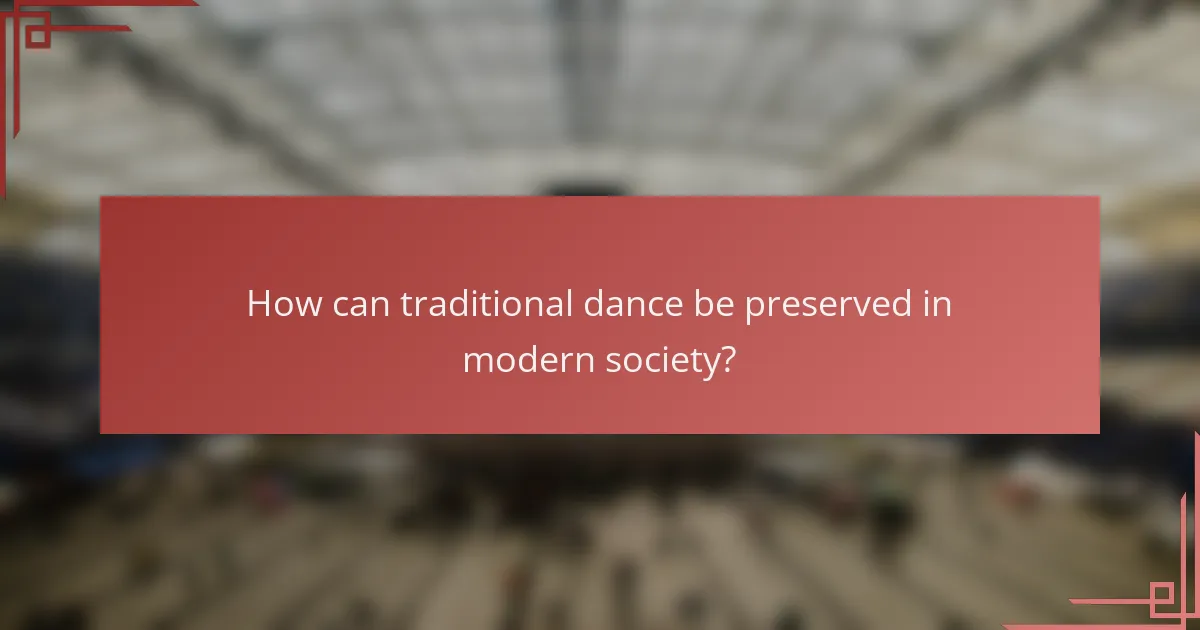
How can traditional dance be preserved in modern society?
Preserving traditional dance in modern society involves a combination of documentation, education, and collaboration with contemporary artists. These approaches ensure that the cultural significance and techniques of traditional dance are maintained while adapting to current contexts.
Documentation and archiving
Documentation and archiving are essential for preserving traditional dance forms. This can include video recordings, written descriptions, and photographs that capture the nuances of performances. Establishing a centralized archive can help safeguard these resources for future generations.
Communities can create digital platforms to share their traditional dance archives, making them accessible to a wider audience. Engaging local historians and dance experts can further enhance the quality and depth of the documentation process.
Education and workshops
Education plays a crucial role in preserving traditional dance. Organizing workshops and classes allows younger generations to learn the techniques and cultural stories behind these dances. Collaborating with local schools can integrate traditional dance into the curriculum, fostering appreciation from an early age.
Offering scholarships or incentives for students to participate in traditional dance programs can encourage greater involvement. Additionally, community events that showcase these dances can help raise awareness and interest among the public.
Collaboration with artists
Collaborating with contemporary artists can breathe new life into traditional dance forms. By merging traditional techniques with modern styles, artists can create innovative performances that attract diverse audiences. This fusion can help traditional dance evolve while still respecting its roots.
Partnerships with local theaters or dance companies can provide platforms for these collaborative performances. Engaging in cross-disciplinary projects, such as combining dance with visual arts or music, can also enhance the visibility and relevance of traditional dance in today’s cultural landscape.

What role do festivals play in the evolution of traditional dance?
Festivals serve as vital platforms for the evolution of traditional dance by fostering creativity and cultural exchange. They provide opportunities for dancers to showcase their skills, innovate with new styles, and connect with audiences, thus ensuring the art form remains relevant and dynamic.
Platform for innovation
Festivals encourage innovation in traditional dance by allowing performers to experiment with new techniques and styles. Dancers often blend traditional movements with contemporary influences, creating unique performances that attract diverse audiences. This fusion not only revitalizes traditional dance but also keeps it aligned with modern cultural trends.
For example, a traditional folk dance might incorporate elements of hip-hop or modern choreography, appealing to younger generations. Such innovations can lead to the development of new dance forms that honor heritage while embracing change.
Networking opportunities for dancers
Festivals provide essential networking opportunities for dancers, choreographers, and cultural organizations. Participants can meet industry professionals, collaborate on projects, and exchange ideas, which can lead to future performances or workshops. This networking is crucial for career development in the arts.
Attending festivals can also help dancers gain visibility, as many events are attended by talent scouts and cultural leaders seeking fresh talent. Building connections in this environment can open doors to grants, sponsorships, and performance opportunities.
Community engagement through participation
Community engagement is a key aspect of festivals, as they often involve local participants in performances and workshops. This inclusivity fosters a sense of belonging and pride among community members, reinforcing cultural identity through shared experiences. Engaging local dancers in traditional performances can also help preserve these art forms for future generations.
Moreover, festivals often include educational components, such as dance classes or demonstrations, which invite community members to learn about their cultural heritage. This active participation not only enriches the festival experience but also strengthens community ties and promotes cultural appreciation.
